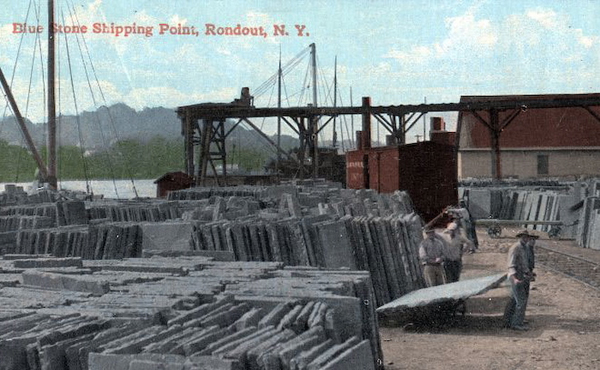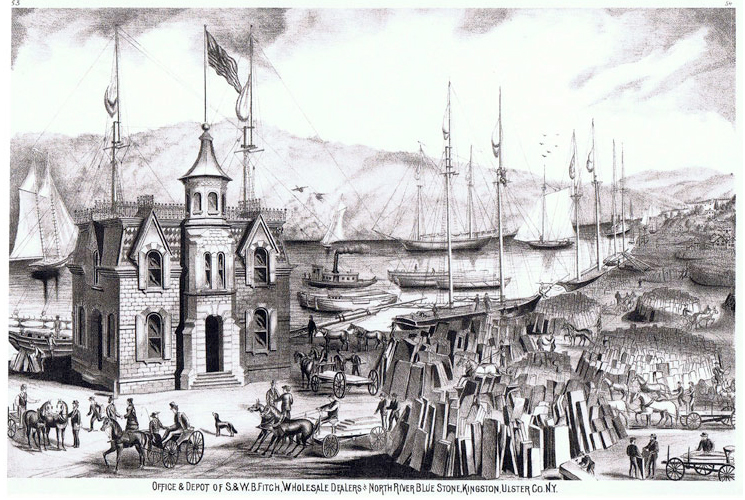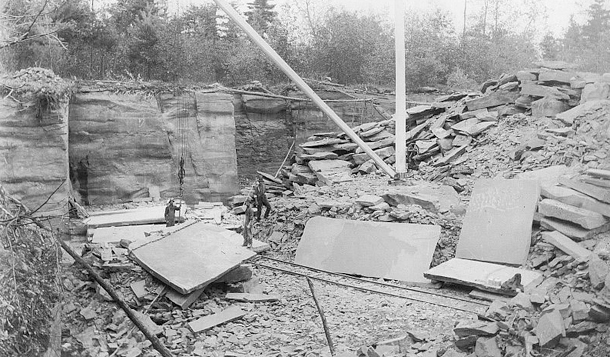Bluestone Timeline
Circa 360-385 million years ago (Upper Devonian era): Sedimentary bluestone, a type of fine-grained sandstone, formed. A layer of sand from river or ocean beds was compressed by subsequent layers of earth and cemented into rock by particles that interlinked the sand. Bluestone has specific differentiating chemical properties and ranges in color from the most characteristic blue-gray to a light purple and even yellow.
Circa 10,000 years ago: Human beings in this region encountered bluestone and began to shape it into arrowheads, vessels, or other useful tools.
Prior to 1830: Native Americans and European settlers made chicken troughs, chimney caps, well covers, building blocks, walls and tombstones out of bluestone.
1831: Bluestone was discovered in Ulster County by Silas Brainard, who recognized its industrial potential and began to quarry it. It marked the start of the bluestone industry in Ulster County and shipment up and down the Hudson to New York and other ports. Eventually, the local bluestone industry employed as many as 10,000 people.
Circa 1845 – 1890: An 18-mile road was built of bluestone “tracks” to support the heavily-laden wagons that carried the stone from quarries in villages now under the Ashokan Reservoir all the way through Kingston’s uptown and down to the creek at Wilbur. (There may possibly have been a similar road from quarries close to Malden.)
By 1850: The bluestone industry is well-established with quarries in Sawkill, Hurley, and other parts of Ulster County and shipments from Wilbur on the Rondout Creek and Malden on the Hudson.
1850-1920: Bluestone for sidewalks, curbstones, building foundations, and other uses is widely used in New York and other cities, shipped from Rondout and Malden on Thomas Cornell’s barges and tugboats. During this period, Kingston’s sidewalks and curbstones were almost entirely made of bluestone.
1850-1852: Kingston’s Old Dutch Church, designed by Minard Lefever, was built of native dressed, and adorned bluestone blocks.
1858: Henry Samson, owner of a leather tanning enterprise, builds an Italian villa of ashlar and rusticated building blocks of bluestone on West Chestnut Street in Kingston.
1870: Simeon and William B. Fitch built the Fitch Building on the Rondout as offices and as a monumental showcase for their bluestone.
Circa 1895: James J. Sweeney, another bluestone dealer, built a large Colonial Revival style house of bluestone on Wurts Street in Rondout. Sweeney bluestone is said to have been used in the base of the Washington Monument.
Circa 1900: Concrete with Portland cement began to replace other building materials, including bluestone for sidewalks, signaling the eventual demise of Ulster County’s bluestone industry over the early decades of the 20th century.
1915: Quarries near West Hurley, Olive Bridge and other hamlets are now buried, flooded during the building of the Ashokan Reservoir.
1938: Sculptor Harvey Fite bought an abandoned 13-acre quarry in Sawkill and, over the next few decades, creates Opus 40, an amazing landscape of drywall-assembled bluestone.
2001: The Bluestone Festival, held on the banks of the Rondout Creek in Kingston. is begun and becomes an annual event.
Present: Bluestone is still quarried in Delaware County though with less thickness than in former times.



